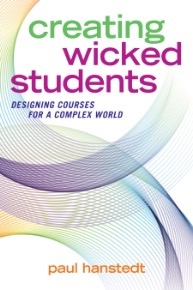learning goals
Select an item by clicking its checkbox

Creating Wicked Students: Designing Courses for a Complex World
Date Reviewed: September 6, 2018
Paul Hanstedt
Sterling, VA: Stylus Publishing, 2018 (x + 180 pages, ISBN 978-1-62036-697-4, $24.95) One might assume that a text called Creating Wicked Students would discuss types of “wicked” problems – complex social-environmental issues that cannot be solved with existing modes of inquiry and decision-making – that instructors might address through a problem-based learning approach. However, this work actually is an introduction ...
Creating Wicked Students: Designing Courses for a Complex World
Paul Hanstedt
Sterling, VA: Stylus Publishing, 2018 (x + 180 pages, ISBN 978-1-62036-697-4, $24.95)
One might assume that a text called Creating Wicked Students would discuss types of “wicked” problems – complex social-environmental issues that cannot be solved with existing modes of inquiry and decision-making – that instructors might address through a problem-based learning approach. However, this work actually is an introduction to course design most useful for beginning instructors or those redesigning their courses according to sound pedagogical principles. Situating himself against those who view higher education as solely preparing students for the workforce or transmitting content, Hanstedt emphasizes the importance of instilling a sense of authority in our students by helping them develop skills and attitudes that will empower them to make meaningful change in the world.
Hanstedt’s holistic vision of education includes attitudes and dispositions alongside skills and content mastery, and will likely resonate with instructors in religious studies and theology. Although he does not explicitly refer to our disciplines, he does offer examples, anecdotes, and insights from colleagues in a variety of fields and institutions, which is a strength of the book. He references seminal work in the scholarship of teaching and learning – including that of: George Kuh (2008, High-Impact Educational Practices, AACU); James Zull (2002, The Art of Changing the Brain, Stylus); and David Krathwohl (2002, “A revision of Bloom’s taxonomy,” Theory into Practice 41) – but does not engage with previous scholarship on wicked problems. Readers interested in learning more about pedagogical approaches to wicked problems could consult the work of the work of: Brown et al. (2010, Tackling Wicked Problems, Routledge); Carcasson (2017, “Deliberative Pedagogy as Critical Connective” in Deliberative Pedagogy, Michigan State University); or Lee (2016, “Systems Thinking,” in Resilience by Design, Springer).
This book could be useful as an introduction to course design for someone less familiar with the fundamentals, such as how to develop measurable learning outcomes, align course goals with institutional goals, nest content within higher-order goals, engage students’ prior knowledge, or incorporate applied learning. The structure of the book allows for one to follow it step-by-step as a course design manual, and it also includes recursive “intermissions” to encourage reflection along the way. In addition, his discussion of how to prompt critical thinking through multiple-choice exams offers helpful strategies for encouraging students to explain their thinking on ambiguous questions with follow-up questions that explain or justify their choice (92-98).
Time and time again, I find that successful online students are those with skills of self-direction, self-regulation, and time-management. Self-directed learners determine their learning needs, set learning goals, locate and access suitable resources for learning, manage their learning activities, monitor and evaluate their performance, and reflect on and reassess their ...
 NOTE: Use the playlist button located in the top left of the video window above to switch between episodes.
NOTE: Use the playlist button located in the top left of the video window above to switch between episodes.
Problem-Based learning at Maastricht University (4:38)
Although a promotional spot for prospective students, this video nicely details goals, roles, stages, and terms common in “problem-based learning.”
Project Based Learning: Explained (3:49)
Through examples, the video promotes this method’s educational value and capacity to develop critical thinking, cooperation, and communication.
Problem-Based Learning at SIU PA Program (11:25)
Goals, roles, and stages (including self-assessment) of problem-based learning demonstrated through a case study approach to physician assistant training. Video emphasizes the active learning dimension of problem-based learning.
